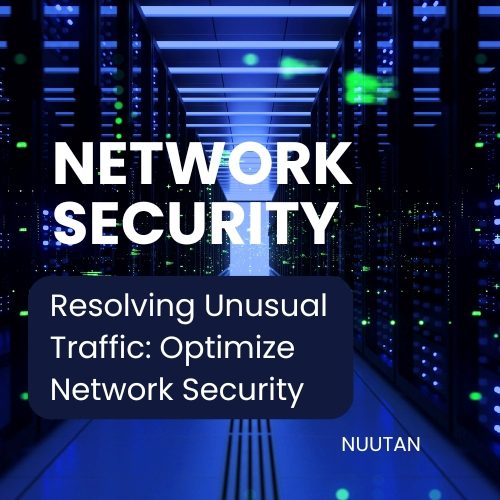PROTECT YOUR NETWORK: UNDERSTANDING UNUSUAL TRAFFIC AND HOW TO RESOLVE IT
(1) Introduction:
In this digital age, you may have noticed the phrase “Our systems have detected unusual traffic from your computer network” While facing this message can be frustrating; it functions as a vital warning of potential threats and vulnerabilities in your network. Understanding the causes and identifying solutions are essential for optimizing the efficacy of your network.
This article on nuutan.com will explore the significance of anomalous network traffic, its impact on your network, and effective resolution strategies.
Let’s investigate! What is unusual traffic?
In the context of network security, “unusual traffic” is defined as any activity that doesn’t belong to the typical standards. Such activity could be evidence of botnets, DDoS attacks, or malicious software seeking to access your network illegally. These occurrences can cause serious problems for your network, including the loss of data and a poor user experience.
(2) Potentially causing “unusual traffic”:
There are two potential sources of “unusual traffic” that need to be pin-pointed before they can be dealt with successfully. One probable reason of unusual traffic is a large number of requests coming from a single IP address or a small number of IP addresses. This could be indicative of a botnet assault, in which a group of infected devices form a network that is directed from a command centre. It’s also possible that a Distributed Denial-of-Service (DDoS) attack is to blame, in which numerous infected machines flood our network with requests.
(3) The question is what to do about the abnormal volume of traffic:
To resolve the issue of unusual traffic, it is necessary to implement effective security measures. Ensure the network has strong firewalls and intrusion detection systems in place before proceeding. These monitor incoming and outgoing traffic for abnormalities and function as the first line of defence. In addition, employing traffic filtering techniques, such as blacklisting suspicious IP addresses or instituting CAPTCHA verifications, can assist in the identification and mitigation of potential threats.
Updating and patching the network’s software and firmware on a regular basis is another essential check for preventing abnormal traffic. Insecure vulnerabilities are frequently found in out-dated software. By promptly deploying updates and patches, we can strengthen our network’s defences and reduce the likelihood of unauthorized access or damage.
(4) Understanding the Impact of Unusual Traffic:
To fully understand the impact of unusual traffic on one’s network’s performance, it is essential to analyse the effects of unusual network activity. When our network experiences such traffic, it can result in slower load times, increased latency, and possible disruptions. These effects can notably hamper the user experience, impact customer satisfaction, and possibly lead online businesses to face financial losses.
Furthermore, unusual traffic volumes can harm a site’s position in search results. Websites that are user-friendly and secure are given higher rankings by search engines like Google. Search engine algorithms may raise red flags if a network regularly encounters unusual traffic, causing the website’s rating to drop. The site’s rank and organic traffic can suffer as a result.
In addition, unusual activity on your network might harm your private information. In order to gain access to a network, steal data, or launch more complex attacks, cybercriminals frequently take use of security holes. In order to prevent data breaches and financial losses, it is crucial to keep your network secure from any suspicious activity.
In addition to security and performance concerns, unusual traffic can also impact your network’s bandwidth
(5) One Example Case:
X-Y-Z Company: Reducing Unusual Activity and Increasing Network Protection
Overview:
When their network began to experience unusual traffic patterns, X-Y-Z Company, an established online retailer, was faced with a challenging situation. This case study shows how they identified the problem, implemented effective measures, and successfully resolved it in order to protect their network and consumer data.
Challenges:
X-Y-Z Company detected a rapid rise in traffic originating from suspicious IP addresses, which negatively impacted network performance and created potential security risks. They noticed that this unusual traffic could have been the result of a DDoS attack, putting their online operations and consumer confidence at risk.
Solution:
The network security team of X-Y-Z Company was quickly called to resolve the issue. They implemented an advanced intrusion detection system (IDS) and a traffic filtering mechanism to identify and block traffic from suspicious IP addresses. In addition, they implemented rate-limiting measures to prevent excessive requests and reduce the possible impact of botnet attacks.
Outcome:
Through their proactive approach, X-Y-Z Company was able to successfully reduce the traffic issue. Their quick reaction and implementation of security measures helped in recovering network stability as well as preserving a secure environment for their clients. By effectively resolving the issue, they were able to protect their network and assure the continuity of their online services.
Understanding what thankfully Learned:
The experience of the XYZ Company shows the importance of proactively network monitoring, quick reaction to emergencies, and the implementation of suitable safety precautions. Regular checks for safety and staying updated of new threats are required to protect networks from unusual traffic incidents.
(6) Critical Tips from Industry Professionals for Safeguarding the Network from Unusual Traffic
Tip1:
The first thing we need to know about unusual traffic is its nature. It could be an indicator of impending network attacks or vulnerabilities. Keep an eye on the flow of traffic and be alert for anything out of the ordinary.
Tip2:
The second takeaway is the significance of instituting fool proof identification and control systems. Strong passwords, multiple methods of authentication, and frequent password changes can help limit the risk of unauthorized access.
Tip3:
Thirdly, always keep the network’s hardware, software, and security solutions up-to-date. It has come to light that several flaws exist in earlier systems. Active patch management is essential for preventing security vulnerabilities.
Tip4:
We should break a large network into more manageable chunks. Networks need to be segmented and secured to stop attacks from spreading over the entire system.
Tip5:
Fifthly, we should consider using intrusion detection and prevention systems (IDS/IPS). Monitoring network traffic in real time, spotting suspicious activity, and automatically blocking hazardous material are all ways to strengthen network security.
Tip6:
Sixth, invest heavily in training our staff. Employees should be taught how to identify malicious software, stay away from harmful downloads, and report any strange network activity promptly.
Tip7:
Seventh, an all-encompassing plan for handling incidents is a must. It provides a methodical framework for responding to traffic emergencies, mitigating their impact, and swiftly resolving them.
Tip8:
The eighth piece of advice: employ threat intelligence. If we want to stay abreast of the latest cyber threats and hacking techniques, it’s important to subscribe to reputable threat intelligence feeds. One can confidently prepare for future threats with this knowledge.
Tip9:
Perform regular audits and reviews of the network we are utilizing to keep an eye out for breaches of security. We can identify security flaws in the network by simulating assaults with penetration testing.
If we take these suggestions into account while planning network security, we may strengthen our defences, spot suspicious behaviour, and prevent damage to the network. Keeping up with best practices is crucial, as network security is an on-going process.
(7) Guidelines for Safeguarding the Network’s Security against Unusual Traffic
Strong Password Policies:
Require that all users have strong passwords that contain a mix of uppercase and lowercase letters, numbers, and special characters. It’s important to change passwords frequently and not use information that can be easily guessed.
Network Monitoring:
The network’s traffic patterns can be analysed with the help of powerful monitoring software. In order to respond to and investigate any suspicious or out-of-the-ordinary activity in a timely manner, it is important to monitor logs on a regular basis and set up alerts.
Firewall Configurations:
Set up firewalls to prevent hackers from gaining access and to filter out suspicious data. Firewall rules should be updated frequently to account for new threats and to allow only essential ports and protocols.
Employee Awareness:
Make workers aware of the risks presented by unusual traffic. Instruct them to recognize fake emails, avoid from visiting questionable websites, and immediately report any suspicious activity on the network or security breaches.
Maintaining Up-to-Date Software:
Always use the most recent version of: the operating system, web browser, and other software. Attackers can obtain access to sensitive information by taking advantage of weaknesses in out-dated software.
Controlled Access:
Use the concept of least privilege to design effective controls for controlled access. Don’t give users any more privileges than they need to perform their jobs. Remove unused permissions on a regular basis.
Data Backup and Recovery:
Keep regular backups of important data and check them to make sure they’re secure. Build a solid data recovery strategy to get things back up and running quickly after an accident or data loss.
Encryption:
Use strong encryption technologies to protect data at rest and in transit. To protect sensitive data, implement security protocols like HTTPS and SSL/TLS and use encryption software.
Network Segmentation:
The impact of any traffic incidents can be minimized by dividing the network into smaller, more isolated parts. Use a firewall with strict rules to limit access across zones and stop lateral movement.
Incident Response Planning:
Prepare for unusual traffic situations by creating a detailed incident response plan to follow. Define who will do what, how they will communicate, and what they will do if a security breach occurs, and what they will do to fix it.
Keep in mind that if all of these recommendations are followed, the network will have an excellent defence against any unusual activity. Be proactive in the face of ever-evolving threats by reviewing and updating your network security procedures on a regular basis.
(8) Choosing the Best Network Security Solutions: A Comparison to Protect against Unusual Traffic
Intrusion Detection Systems (IDS):
IDS monitors network traffic for malicious activity and alerts administrators when something unusual occurs. Enhance network security by gaining real-time visibility into anomalous traffic patterns and the ability to automatically block potentially dangerous data.
UTM (Unified Threat Management):
It’s a tool that consolidates various forms of network security into o(It is a system that consolidates numerous levels of network security into a single piece of hardware. By combining firewall, intrusion detection and prevention, antivirus, and content filtering technologies, they provide an integrated means of defense against a variety of dangers, including anomalous traffic.
Firewalls of the Future:
Next-Generation Firewalls (NGFWs) provide features such as deep packet inspection, application awareness, and user-level controls. These technologies improve security against anomalous traffic by doing finer-grained analysis to detect and prevent suspicious behaviour.
Secure Web Gateways (SWG):
A SWG solution safeguards networks from malicious websites and infected downloads, among other online threats. They provide URL filtering, virus detection, and data loss protection services to provide secure web browsing and prevent access to harmful sites.
SIEM (Security Information and Event Management) solutions:
It examines data from a variety of network monitors for signals of odd behaviour or assaults. They provide a consolidated view of network security events, increasing the possibility of prompt detection and response to threats.
Threat Intelligence Platforms:
Threat intelligence platforms gather data from various sources to shed light on emerging threats and attack trends. They employ real-time threat intelligence feeds and powerful algorithms to help businesses detect and prevent abnormal traffic.
When selecting a network security solution, consider factors such as network size and complexity, the need for control and visibility, scalability, and cost. Compare these solutions based on their features, ease of management, vendor dependability, and network compatibility.
Keep in mind that there is no one-size-fits-all method for detecting suspicious web activity. To effectively protect the network, a layered approach incorporating numerous security technologies, regular updates, and proactive monitoring is required.
(9) Trends in the Future: Predicting Unusual Traffic and Strengthening Network Security
Point1:
Network safety is being completely transformed by AI-powered solutions. Machine learning algorithms can sift through mountains of data in search of trends and outliers, allowing for the rapid identification of suspicious activity and the prevention of security breaches.
Point2:
The Zero Trust model of security is an alternative to the more conventional “walls and alarms” method. By demanding tight identity verification and continual authorization, it eliminates the possibility of suspicious traffic getting through the perimeter defences without being detected.
Point3:
Secure Access solution Edge (SASE) is a cloud-delivered solution that combines network security and WAN capabilities. Comprehensive protection against malicious traffic is provided by the incorporation of multiple layers of security, including secure web gateways, firewalls, and data loss prevention.
Point4:
When it comes to protecting against sophisticated cyber-attacks, endpoint detection and response (EDR) solutions are where it’s at. These tools keep an eye on what’s happening on endpoints, flag any suspicious behaviour, and take action in real time to stop attacks.
Point5:
As more people use cloud services, protecting sensitive data is more important than ever. Cloud-based security solutions provide centralized security management and scalability, and they offer robust protection against unexpected traffic and emerging threats.
Point6:
The growth of IoT devices presents new issues for data security in the Internet of Things (IoT). Security solutions for the Internet of Things are geared toward preventing malicious activity on linked devices and networks and maintaining the privacy and security of IoT transmissions.
Point7:
Analysing the patterns of activity of users and entities in a network is the goal of User and Entity Behaviour Analytics (UEBA), which makes use of machine learning methods to do so. UEBA systems analyse user behaviour to detect insider threats and other forms of intrusion.
Point8:
Hunting for malicious activity and other forms of suspicious network activity is known as “threat hunting“. Security teams employ cutting-edge analytic tools and threat intelligence to detect and counter threats before they may do serious harm.
Point9:
Containers are gaining popularity for deploying applications. Protecting containerized environments, identifying suspicious traffic, and preserving the integrity of containerized applications are the primary concerns of container security solutions.
Point10:
The importance of data privacy legislation means that firms must make compliance a top priority. Built-in privacy controls, data encryption, and compliance management capabilities found in network security systems aid in spotting and blocking suspicious activity while also satisfying regulatory mandates.
If we keep up with these developments, we can modify the network security plan to account for new risks and block out any suspicious activity. If we want the network to be secure and reliable, we should incorporate these trends into the entire security plan.
(10) Step-by-Step Guide for Preventing Unusual Network Traffic
Step1:
Frequently evaluate the network’s infrastructure. The firewall, access controls, and other network devices’ settings all affect the network’s security.
Step2:
Utilize Intrusion Detection System (IDS) tools to monitor network traffic and spot suspicious activity or malicious attacks. We set up notifications so that administrators can be informed right away of any found threats.
Step3:
The concept of least privilege necessitates the implementation of strict access constraints. Only grant users the rights they require to carry out their duties. On a regular basis, we want to modify user permissions and eliminate unused ones.
Step4:
Verify that all of our employees have received sufficient instruction in effective network security practices. Tell them to be on their watch, to report any odd network activity, and to spot phishing attempts.
Step5:
For the safety and security of our network and computer, it is crucial to maintain current software and firmware. Regular software updates remove security gaps and strengthen it against emerging threats.
Step6:
By dividing the network into smaller segments, network segmentation can be used to lessen the effects of traffic problems. It is recommended that various departments or crucial systems each have their own private virtual local area networks (VLANs) or subnets.
Step7:
The practice of asking users to authenticate their identities using multiple forms of identification before getting access to a resource that demands high levels of security is known as multi-factor authentication (MFA). Security is increased by multi-factor authentication (MFA), which makes it harder for unauthorized users to get around.
Step8:
It’s crucial to regularly back up our data in order to prevent it from disappearing due to a security breach. To ensure a smooth restore in case of an emergency, make sure backups are securely stored and that their integrity is regularly checked.
Step9:
Utilize network monitoring technologies to examine traffic patterns, identify suspicious activities, and swiftly take the necessary action. Alerts for known attack signatures and odd traffic patterns should be made in order to identify and stop security breaches.
Step10:
Make certain that we have a strategy in place to address any unforeseen traffic issues. Give a brief description of the actions to be taken in the event of an incident, including who should take what action and how they should communicate.
We can fortify the network’s defences against malicious or other suspicious traffic if we adhere to these recommendations. Security policies should be regularly evaluated and modified in order to combat emerging threats and keep a stable network.
(11) Avoiding Common Mistakes: Network Security Issues and Strange Traffic Analysis
Avoid1:
Passwords that are too easy to guess or too obvious to crack are a common issue. The security of passwords like “password” or “123456” is far too weak. Use a combination of capital, lowercase, numbers, symbols, and long passwords that are challenging to decipher.
Avoid2:
Not routinely updating security applications, operating systems, and network hardware to fix vulnerabilities. Maintain the proactive attitude by promptly patching and updating to protect against known security flaws.
Avoid3:
A frequent error in the field of network security is giving personnel insufficient training. In training sessions, it should be underlined how important it is to report unusual network behaviour and how to recognize phishing emails.
Avoid4:
Inadequately configured firewalls might expose networks to intrusions and unusual traffic. It is important to regularly check the rules and configurations of the firewall to ensure that they are compliant with security policy and are effective at thwarting threats.
Avoid5:
Unreported aberrant traffic may occur if efficient network monitoring solutions are not installed. Keep a close eye on your network, looking out for oddities, unusual traffic, and suspicious activity.
Avoid6:
Critical issues are more likely to go undiscovered if regular security audits are not performed. Conduct routine network audits to look for vulnerabilities, confirm that the network complies with security requirements, and make any necessary improvements.
Avoid7:
Common mistakes include failing to regularly backup essential data. Create a backup schedule and verify the backups to make sure they are accurate and comprehensive. This avoids data loss and facilitates data recovery in the event of a security compromise.
Avoid8:
Unauthorized Access and Weird Traffic Occurrences are More Likely to Occur When Access Controls Are Not Managed Correctly Poorly maintained access controls increase the likelihood of unauthorized access and strange traffic patterns. User permissions should be regularly evaluated, unnecessary ones eliminated, and the principle of least privilege rigidly upheld.
Avoid9:
Inadequate incident response planning could result in unneeded downtime if security events are not anticipated in advance. By deciding who will do what and how, you may create a thorough plan for handling situations.
Avoid10:
The most recent dangers and threats are not communicated to staff personnel who don’t take part in on-going security awareness training. It’s critical to maintain a secure network environment, so it’s necessary to keep our team informed of the newest security risks, social engineering strategies, and best practices.
The network will be less susceptible to assaults and more resistant to aberrant data flows if these dangers are avoided and proactive measures are taken to secure it.
(12) Challenges of Network Security and Unusual Traffic in the Future
Challenge1:
New and more complex threats will emerge in the future, requiring regular modifications to network security. In order to actively protect the network, we should stay informed of new attack methods such as AI-driven attacks and zero-day vulnerabilities.
Challenge2:
As IoT devices expand, it will be increasingly important to ensure their safety. Prevent weaknesses in the Internet of Things (IoT) from causing unusual traffic problems by enforcing strong security measures, such as strong authentication, encryption, and frequent updates.
Challenge3:
Strong cloud security measures will be required as cloud adoption continues to rise. Protect it from cloud-based dangers by using cloud-specific security measures, including data encryption, access limits, and strong identity and access management.
Challenge4:
In order to detect more advanced threats, network security solutions will increasingly rely on artificial intelligence and machine learning algorithms. These tools can sift through mountains of information to spot trends, single out outliers, and prevent or respond to unusual traffic occurrences.
Challenge5:
With the rise of Zero-Trust Architecture, traditional perimeter-based defences will become obsolete. This strategy prioritizes constant authentication of users and devices, stringent restriction of access, and monitoring for anomalous activity.
Challenge6:
Regulations governing the privacy of personal information will become more stringent over time. Protect private information and stay clear of fines by staying in line with laws like the General Data Protection Regulation and the California Consumer Privacy Act.
Challenge7:
The future of network security depends heavily on the use of automation and orchestration. The identification, response, and mitigation of unusual traffic situations can be expedited by streamlining security processes, automating regular tasks, and integrating security solutions.
Challenge8:
Prioritizing identity and access management is a key step toward a more user-centric security model. Use measures like single sign-on, behavioural analytics, and multi-factor authentication to keep hackers out and legitimate users safe.
Challenge9:
Collaboration and sharing of threat intelligence will become increasingly important. There will be a rise in the use of information sharing platforms and industry cooperation as businesses band together to face new security concerns and discuss strange traffic patterns.
Challenge10:
Proactive incident response and constant monitoring are necessities for effective network security. To effectively detect, mitigate, and recover from unusual traffic occurrences, it is important to use real-time monitoring technologies, undertake frequent security audits, and build robust incident response strategies.
By anticipatorily adapting the network security methods, utilizing developing technology, and avoiding potential dangers linked with anomalous traffic occurrences, we can benefit from knowing about these upcoming trends. If we want the network to be secure and reliable, we need to regularly evaluate the security measures and adapt them.
(13) Engaging Interactive Elements to Improve Awareness of Unusual Network Activity and Defences
Interactive1:
Interactive quizzes put our understanding of malicious network activity and security to the test. These quizzes have the potential to improve retention by providing timely feedback on student performance.
Interactive2:
Interactive checklists are available to help us safeguard the network from malicious or suspicious activity. These helpful, interactive tools will keep us organized and make sure we don’t forget about any vital safety measures.
Interactive3:
Interactive simulations of real-world settings that we can take part in We get to make choices and see how they play out in these simulations, learning how to deal with unexpected traffic situations.
Interactive4:
Browse eye-catching, interactive info-graphics that simplify complicated ideas in network security for the layperson. Engaging with this data through these visual aids is a great way to learn and retain the material.
Interactive5:
Participate in scenario-based challenges that put us in the position of a network administrator faced with a variety of scenarios involving suspicious traffic. Our ability to analyze problems, make decisions, and evaluate their outcomes is being tested here.
Interactive6:
Gain entry to simulated lab settings where we can try out different setups of network security technologies. Practice installing security measures and managing odd traffic issues in a controlled setting with the help of these interactive labs.
Interactive7:
Attend live webinars or streaming sessions run by seasoned professionals in the field of network security. Protect the network from malicious or otherwise odd traffic by participating in real-time discussions, asking questions, and learning from the answers.
Interactive8:
Access step-by-step, interactive tutorials that cover everything from setting up firewalls to configuring a VPN; these courses will give us real-world experience while teaching us how to improve the network’s security.
Interactive9:
Participate in online communities and discussion forums already devoted to the topic of network security and suspicious activity. To gain a broader perspective and be abreast of developments in the field, it is important to interact with other experts, ask questions, and exchange experiences.
Interactive10:
Learn about various network security ideas, methods, and best practices by watching interactive videos and movies. These films frequently feature interactive elements, making for a fun and interesting educational experience.
Through our participation in the learning process facilitated by these interactive features, we will gain a deeper knowledge of network security and the knowledge and abilities to properly safeguard our network from anomalous traffic situations.
(14) One last thought on preventing unusual network traffic
In conclusion, the network’s ability to recognize and address instances of unexpected traffic is crucial to its security and dependability. By staying current with market advancements and best practices, you can strengthen the network’s defence against threats.
The following are the important points:
Point-1:
Pay Attention! Regularly monitor the network for anomalies and suspicious activities, and investigate anything that seems unusual immediately soon.
Point-2:
It is important to enforce password restrictions, update software routinely, and properly configure firewalls and access controls. Any secure network is built on these safeguards. So that they may actively contribute to ensuring the integrity of the network infrastructure, employees should receive comprehensive training on network security best practices.
Point-3:
Utilize advances like cloud security, zero-trust architecture, and AI-based threat detection to stay on top of evolving dangers and filter out anomalous traffic.
Point-4:
Participate in industry-wide initiatives to share threat intelligence and work together to combat new threats and odd traffic patterns.
Point-5:
It is critical to establish an incident response strategy that clearly defines roles, responsibilities, and step-by-step procedures for responding to anomalous traffic incidents in order to detect, mitigate, and recover from them.
Point-6:
The network’s defences against malicious or other unexpected traffic should always be improved. In order to take into account new hazards, it is crucial to regularly review and upgrade security measures. By using the proper strategies, drawing on expert advice, and keeping an up-to-date knowledge base, we can secure the network and ensure our company’s online safety.
(15) Attention! Network Security Must Be Priority #1 Right Now
Now is the time to take steps to prevent damage to the network from unusual traffic. To improve the network’s safety, try these suggestions:
Suggestion1:
Evaluate the connections to find security holes and optimization opportunities; we should perform a thorough audit of our network’s infrastructure.
Suggestion2:
It is important to educate personnel on best practices for network security, enforce stringent password regulations, and correctly configure firewalls.
Suggestion3:
The network could benefit from the installation of intrusion detection systems (IDS), next-generation firewalls (NGFW), and other specialized security tools.
Suggestion4:
Utilize the latest best practices in network security by participating in webinars and reading up on industry publications.
Suggestion5:
To effectively respond to and recover from atypical traffic incidents, we should draft a detailed incident response plan outlining the necessary procedures to take.
Suggestion6:
Use information-sharing platforms and interact with other professionals in our field to jointly address new security challenges and learn from the experiences of those who have faced similar problems.
Suggestion7:
We should regularly update our staff on the best network security procedures and stress the importance of their part in keeping the network secure.
Suggestion8:
Continuous network monitoring, penetration testing, and routine reviews of security measures should be implemented to ensure their continued efficacy.
Suggestion9:
A preventative and complete strategy is needed to keep the network secure. Do not wait for an incident to occur before taking precautions to prevent malicious or otherwise suspicious network activity. We can protect the security of the network and its data and systems from intrusion by adopting these steps.
Nuutan.com is forever grateful for the enduring loyalty of its readers.
Warmest Regards











